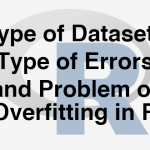
What is a best model? How to build?
In previous section, we studied about ROC and AUC
- A model with maximum accuracy /least error
- A model that uses maximum information available in the given data
- A model that has minimum squared error
- A model that captures all the hidden patterns in the data
- A model that produces the best perdition results
Model Selection
- How to build/choose a best model?
- Error on the training data is not a good meter of performance on future data
- How to select the best model out of the set of available models ?
- Are there any methods/metrics to choose best model?
- What is training error? What is testing error? What is hold out sample error?
LAB: The Most Accurate Model
- Data: Fiberbits/Fiberbits.csv
- Build a decision tree to predict active_user
- What is the accuracy of your model?
- Grow the tree as much as you can and achieve 95% accuracy.
Solution
- Model-1
library(rpart)
library(rpart.plot)## Warning: package 'rpart.plot' was built under R version 3.1.3Fiber_bits_tree1<-rpart(active_cust~., method="class", control=rpart.control(minsplit=30, cp=0.01), data=Fiberbits)
prp(Fiber_bits_tree1)Fbits_pred1<-predict(Fiber_bits_tree1, type="class")
conf_matrix1<-table(Fbits_pred1,Fiberbits$active_cust)
accuracy1<-(conf_matrix1[1,1]+conf_matrix1[2,2])/(sum(conf_matrix1))
accuracy1## [1] 0.84629- Model-2
Fiber_bits_tree2<-rpart(active_cust~., method="class", control=rpart.control(minsplit=5, cp=0.000001), data=Fiberbits)
Fbits_pred2<-predict(Fiber_bits_tree2, type="class")
conf_matrix2<-table(Fbits_pred2,Fiberbits$active_cust)
accuracy2<-(conf_matrix2[1,1]+conf_matrix2[2,2])/(sum(conf_matrix2))
accuracy2## [1] 0.95063Different Type of Datasets and Errors
The Training Error
- The accuracy of our best model is 95%. Is the 5% error model really good?
- The error on the training data is known as training error.
- A low error rate on training data may not always mean the model is good.
- What really matters is how the model is going to perform on unknown data or test data.
- We need to find out a way to get an idea on error rate of test data.
- We may have to keep aside a part of the data and use it for validation.
- There are two types of datasets and two types of errors
Two Types of Datasets
- There are two types of datasets
- Training set: This is used in model building. The input data
- Test set: The unknown dataset. This dataset is gives the accuracy of the final model
- We may not have access to these two datasets for all machine learning problems. In some cases, we can take 90% of the available data and use it as training data and rest 10% can be treated as validation data
- Validation set: This dataset kept aside for model validation and selection. This is a temporary subsite to test dataset. It is not third type of data
- We create the validation data with the hope that the error rate on validation data will give us some basic idea on the test error
Types of Errors
- The training error
- The error on training dataset
- In-time error
- Error on the known data
- Can be reduced while building the model
- The test error
- The error that matters
- Out-of-time error
- The error on unknown/new dataset.
“A good model will have both training and test error very near to each other and close to zero”
The Problem of Over Fitting
- In search of the best model on the given data we add many predictors, polynomial terms, Interaction terms, variable transformations, derived variables, indicator/dummy variables etc.,
- Most of the times we succeed in reducing the error. What error is this?
- So by complicating the model we fit the best model for the training data.
- Sometimes the error on the training data can reduce to near zero
- But the same best model on training data fails miserably on test data.
- Imagine building multiple models with small changes in training data. The resultant set of models will have huge variance in their parameter estimates.
- The model is made really complicated, that it is very sensitive to minimal changes
- By complicating the model the variance of the parameters estimates inflates
- Model tries to fit the irrelevant characteristics in the data
- Over fitting
- The model is super good on training data but not so good on test data
- We fit the model for the noise in the data
- Less training error, high testing error
- The model is over complicated with too many predictors
- Model need to be simplified
- A model with lot of variance
LAB: Model with huge Variance
- Data: Fiberbits/Fiberbits.csv
- Take initial 90% of the data. Consider it as training data. Keep the final 10% of the records for validation.
- Build the best model(5% error) model on training data.
- Use the validation data to verify the error rate. Is the error rate on the training data and validation data same?
Solution
fiber_bits_train<-Fiberbits[1:90000,]
fiber_bits_validation<-Fiberbits[90001:100000,]Model on training data
Fiber_bits_tree3<-rpart(active_cust~., method="class", control=rpart.control(minsplit=5, cp=0.000001), data=fiber_bits_train)
Fbits_pred3<-predict(Fiber_bits_tree3, type="class")
conf_matrix3<-table(Fbits_pred3,fiber_bits_train$active_cust)
accuracy3<-(conf_matrix3[1,1]+conf_matrix3[2,2])/(sum(conf_matrix3))
accuracy3## [1] 0.9524889Validation Accuracy
fiber_bits_validation$pred <- predict(Fiber_bits_tree3, fiber_bits_validation,type="class")
conf_matrix_val<-table(fiber_bits_validation$pred,fiber_bits_validation$active_cust)
accuracy_val<-(conf_matrix_val[1,1]+conf_matrix_val[2,2])/(sum(conf_matrix_val))
accuracy_val## [1] 0.7116Error rate on validation data is more than the training data error.
The Problem of Under-fitting
- Simple models are better. Its true but is that always true? May not be always true.
- We might have given it up too early. Did we really capture all the information?
- Did we do enough research and future reengineering to fit the best model? Is it the best model that can be fit on this data?
- By being over cautious about variance in the parameters, we might miss out on some patterns in the data.
- Model need to be complicated enough to capture all the information present.
- If the training error itself is high, how can we be so sure about the model performance on unknown data?
- Most of the accuracy and error measuring statistics give us a clear idea on training error, this is one advantage of under fitting, we can identify it confidently.
- Under fitting
- A model that is too simple
- A mode with a scope for improvement
- A model with lot of bias
LAB: Model with huge Bias
- Lets simplify the model.
- Take the high variance model and prune it.
- Make it as simple as possible.
- Find the training error and validation error.
Solution
- Simple Model
Fiber_bits_tree4<-rpart(active_cust~., method="class", control=rpart.control(minsplit=30, cp=0.25), data=fiber_bits_train)
prp(Fiber_bits_tree4)Fbits_pred4<-predict(Fiber_bits_tree4, type="class")
conf_matrix4<-table(Fbits_pred4,fiber_bits_train$active_cust)
conf_matrix4##
## Fbits_pred4 0 1
## 0 11209 921
## 1 25004 52866accuracy4<-(conf_matrix4[1,1]+conf_matrix4[2,2])/(sum(conf_matrix4))
accuracy4## [1] 0.7119444- Validation accuracy
fiber_bits_validation$pred1 <- predict(Fiber_bits_tree4, fiber_bits_validation,type="class")
conf_matrix_val1<-table(fiber_bits_validation$pred1,fiber_bits_validation$active_cust)
accuracy_val1<-(conf_matrix_val1[1,1]+conf_matrix_val1[2,2])/(sum(conf_matrix_val1))
accuracy_val1## [1] 0.4224Model Bias and Variance
- Over fitting
- Low Bias with High Variance
- Low training error – ‘Low Bias’
- High testing error
- Unstable model – ‘High Variance’
- The coefficients of the model change with small changes in the data
- Under fitting
- High Bias with low Variance
- High training error – ‘high Bias’
- testing error almost equal to training error
- Stable model – ‘Low Variance’
- The coefficients of the model doesn’t change with small changes in the data
The Bias-Variance Decomposition
\[Y = f(X)+\epsilon\] \[Var(\epsilon) = \sigma^2\] \[Squared Error = E[(Y -\hat{f}(x_0))^2 | X = x_0 ]\] \[= \sigma^2 + [E\hat{f}(x_0)-f(x_0)]^2 + E[\hat{f}(x_0)-E\hat{f}(x_0)]^2\] \[= \sigma^2 + (Bias)^2(\hat{f}(x_0))+Var(\hat{f}(x_0 ))\]
Overall Model Squared Error = Irreducible Error + \(Bias^2\) + Variance
Bias-Variance Decomposition
- Overall Model Squared Error = Irreducible Error + \(Bias^2\) + Variance
- Overall error is made by bias and variance together
- High bias low variance, Low bias and high variance, both are bad for the overall accuracy of the model
- A good model need to have low bias and low variance or at least an optimal where both of them are jointly low
- How to choose such optimal model. How to choose that optimal model complexity
Choosing optimal model-Bias Variance Tradeoff
Bias Variance Tradeoff
Test and Training Error
Choosing Optimal Model
- Unfortunately
- There is no scientific method of choosing optimal model complexity that gives minimum test error.
- Training error is not a good estimate of the test error.
- There is always bias-variance tradeoff in choosing the appropriate complexity of the model.
- We can use cross validation methods, boot strapping and bagging to choose the optimal and consistent model
Holdout Data Cross Validation
- The best solution is out of time validation. Or the testing error should be given high priority over the training error.
- A model that is performing good on training data and equally good on testing is preferred.
- We may not have the test data always. How do we estimate test error?
- We take the part of the data as training and keep aside some potion for validation. May be 80%-20% or 90%-10%
- Data splitting is a very basic intuitive method
LAB: Holdout Data Cross Validation
- Data: Fiberbits/Fiberbits.csv
- Take a random sample with 80% data as training sample
- Use rest 20% as holdout sample.
- Build a model on 80% of the data. Try to validate it on holdout sample.
- Try to increase or reduce the complexity and choose the best model that performs well on training data as well as holdout data
Solution
- Caret is a good package for cross validation
library(caret)
sampleseed <- createDataPartition(Fiberbits$active_cust, p=0.80, list=FALSE)
train_new <- Fiberbits[sampleseed,]
hold_out <- Fiberbits[-sampleseed,]- Model1
library(rpart)
Fiber_bits_tree5<-rpart(active_cust~., method="class", control=rpart.control(minsplit=5, cp=0.000001), data=train_new)
Fbits_pred5<-predict(Fiber_bits_tree5, type="class")- Accuracy on Training Data
conf_matrix5<-table(Fbits_pred5,train_new$active_cust)
conf_matrix5##
## Fbits_pred5 0 1
## 0 31482 1689
## 1 2230 44599accuracy5<-(conf_matrix5[1,1]+conf_matrix5[2,2])/(sum(conf_matrix5))
accuracy5## [1] 0.9510125- Model1 Validation accuracy
hold_out$pred <- predict(Fiber_bits_tree5, hold_out, type="class")
conf_matrix_val<-table(hold_out$pred,hold_out$active_cust)
conf_matrix_val##
## 0 1
## 0 7003 1333
## 1 1426 10238accuracy_val<-(conf_matrix_val[1,1]+conf_matrix_val[2,2])/(sum(conf_matrix_val))
accuracy_val## [1] 0.86205- Model2
Fiber_bits_tree5<-rpart(active_cust~., method="class", control=rpart.control(minsplit=30, cp=0.05), data=train_new)
Fbits_pred5<-predict(Fiber_bits_tree5, type="class")
conf_matrix5<-table(Fbits_pred5,train_new$active_cust)- Accuracy on Training Data
accuracy5<-(conf_matrix5[1,1]+conf_matrix5[2,2])/(sum(conf_matrix5))
accuracy5## [1] 0.7882375- Model2 Validation accuracy
hold_out$pred <- predict(Fiber_bits_tree5, hold_out,type="class")
conf_matrix_val<-table(hold_out$pred,hold_out$active_cust)
accuracy_val<-(conf_matrix_val[1,1]+conf_matrix_val[2,2])/(sum(conf_matrix_val))
accuracy_val## [1] 0.79225- Model3
Fiber_bits_tree5<-rpart(active_cust~., method="class", control=rpart.control(minsplit=30, cp=0.001), data=train_new)
Fbits_pred5<-predict(Fiber_bits_tree5, type="class")
conf_matrix5<-table(Fbits_pred5,train_new$active_cust)- Accuracy on Training Data
accuracy5<-(conf_matrix5[1,1]+conf_matrix5[2,2])/(sum(conf_matrix5))
accuracy5## [1] 0.8673- Model3 Validation accuracy
hold_out$pred <- predict(Fiber_bits_tree5, hold_out,type="class")
conf_matrix_val<-table(hold_out$pred,hold_out$active_cust)
accuracy_val<-(conf_matrix_val[1,1]+conf_matrix_val[2,2])/(sum(conf_matrix_val))
accuracy_val## [1] 0.8661Ten-fold Cross – Validation
- Divide the data into 10 parts(randomly)
- Use 9 parts as training data(90%) and the tenth part as holdout data(10%)
- We can repeat this process 10 times
- Build 10 models, find average error on 10 holdout samples. This gives us an idea on testing error
K-fold Cross Validation
- A generalization of cross validation.
- Divide the whole dataset into k equal parts
- Use kth part of the data as the holdout sample, use remaining k-1 parts of the data as training data
- Repeat this K times, build K models. The average error on holdout sample gives us an idea on the testing error
- Which model to choose?
- Choose the model with least error and least complexity
- Or the model with less than average error and simple (less parameters)
- Finally use complete data and build a model with the chosen number of parameters
- Note: Its better to choose K between 5 to 10. Which gives 80% to 90% training data and rest 20% to 10% is holdout data
LAB – K-fold Cross Validation
- Build a tree model on the fiber bits data.
- Try to build the best model by making all the possible adjustments to the parameters.
- What is the accuracy of the above model?
- Perform 10 -fold cross validation. What is the final accuracy?
- Perform 20 -fold cross validation. What is the final accuracy?
- What can be the expected accuracy on the unknown dataset?
Solution
- Model on complete training data
Fiber_bits_tree3<-rpart(active_cust~., method="class", control=rpart.control(minsplit=10, cp=0.000001), data=Fiberbits)
Fbits_pred3<-predict(Fiber_bits_tree3, type="class")
conf_matrix3<-table(Fbits_pred3,Fiberbits$active_cust)
conf_matrix3##
## Fbits_pred3 0 1
## 0 38154 2849
## 1 3987 55010- Accuracy on Traing Data
accuracy3<-(conf_matrix3[1,1]+conf_matrix3[2,2])/(sum(conf_matrix3))
accuracy3## [1] 0.93164- k-fold Cross Validation building
- K=10
library(caret)
train_dat <- trainControl(method="cv", number=10)Need to convert the dependent variable to factor before fitting the model
Fiberbits$active_cust<-as.factor(Fiberbits$active_cust)- Building the models on K-fold samples
library(e1071)## Warning: package 'e1071' was built under R version 3.1.3K_fold_tree<-train(active_cust~., method="rpart", trControl=train_dat, control=rpart.control(minsplit=10, cp=0.000001), data=Fiberbits)
K_fold_tree$finalModel## n= 100000
##
## node), split, n, loss, yval, (yprob)
## * denotes terminal node
##
## 1) root 100000 42141 1 (0.42141000 0.57859000)
## 2) relocated>=0.5 12348 954 0 (0.92274052 0.07725948) *
## 3) relocated< 0.5 87652 30747 1 (0.35078492 0.64921508)
## 6) Speed_test_result< 78.5 27517 10303 0 (0.62557692 0.37442308) *
## 7) Speed_test_result>=78.5 60135 13533 1 (0.22504365 0.77495635) *prp(K_fold_tree$finalModel)Kfold_pred<-predict(K_fold_tree)
conf_matrix6<-confusionMatrix(Kfold_pred,Fiberbits$active_cust)
conf_matrix6## Confusion Matrix and Statistics
##
## Reference
## Prediction 0 1
## 0 28608 11257
## 1 13533 46602
##
## Accuracy : 0.7521
## 95% CI : (0.7494, 0.7548)
## No Information Rate : 0.5786
## P-Value [Acc > NIR] : < 2.2e-16
##
## Kappa : 0.4879
## Mcnemar's Test P-Value : < 2.2e-16
##
## Sensitivity : 0.6789
## Specificity : 0.8054
## Pos Pred Value : 0.7176
## Neg Pred Value : 0.7750
## Prevalence : 0.4214
## Detection Rate : 0.2861
## Detection Prevalence : 0.3987
## Balanced Accuracy : 0.7422
##
## 'Positive' Class : 0
## - K=20
library(caret)
train_dat <- trainControl(method="cv", number=20)Need to convert the dependent variable to factor before fitting the model
Fiberbits$active_cust<-as.factor(Fiberbits$active_cust)Building the models on K-fold samples
library(e1071)
K_fold_tree_1<-train(active_cust~., method="rpart", trControl=train_dat, control=rpart.control(minsplit=10, cp=0.000001), data=Fiberbits)
K_fold_tree_1$finalModel## n= 100000
##
## node), split, n, loss, yval, (yprob)
## * denotes terminal node
##
## 1) root 100000 42141 1 (0.42141000 0.57859000)
## 2) relocated>=0.5 12348 954 0 (0.92274052 0.07725948) *
## 3) relocated< 0.5 87652 30747 1 (0.35078492 0.64921508)
## 6) Speed_test_result< 78.5 27517 10303 0 (0.62557692 0.37442308) *
## 7) Speed_test_result>=78.5 60135 13533 1 (0.22504365 0.77495635) *prp(K_fold_tree_1$finalModel)Kfold_pred<-predict(K_fold_tree_1)Caret package has confusion matrix function
conf_matrix6_1<-confusionMatrix(Kfold_pred,Fiberbits$active_cust)
conf_matrix6_1## Confusion Matrix and Statistics
##
## Reference
## Prediction 0 1
## 0 28608 11257
## 1 13533 46602
##
## Accuracy : 0.7521
## 95% CI : (0.7494, 0.7548)
## No Information Rate : 0.5786
## P-Value [Acc > NIR] : < 2.2e-16
##
## Kappa : 0.4879
## Mcnemar's Test P-Value : < 2.2e-16
##
## Sensitivity : 0.6789
## Specificity : 0.8054
## Pos Pred Value : 0.7176
## Neg Pred Value : 0.7750
## Prevalence : 0.4214
## Detection Rate : 0.2861
## Detection Prevalence : 0.3987
## Balanced Accuracy : 0.7422
##
## 'Positive' Class : 0
## Bootstrap Cross Validation
Bootstrap Methods
- Boot strapping is a powerful tool to get an idea on accuracy of the model and the test error
- Can estimate the likely future performance of a given modeling procedure, on new data not yet realized.
- The Algorithm
- We have a training data is of size N
- Draw random sample with replacement of size N – This gives a new dataset, it might have repeated observations, some observations might not have even appeared once.
- Create B such new datasets. These are called boot strap datasets
- Build the model on these B datasets, we can test the models on the original training dataset.
Bootstrap Example
- Example
- We have a training data is of size 500
- Boot Strap Data-1:
- Create a dataset of size 500. To create this dataset, draw a random point, note it down, then replace it back. Again draw another sample point. Repeat this process 500 times. This makes a dataset of size 500. Call this as Boot Strap Data-1
- Multiple Boot Strap datasets
- Repeat the procedure in step -2 multiple times. Say 200 times. Then we have 200 Boot Strap datasets
- We can build the models on these 200 boost strap datasets and the average error gives a good idea on overall error. We can even use the original training data as the test data for each of the models
LAB: Bootstrap Cross Validation
- Draw a boot strap sample with sufficient sample size
- Build a tree model and get an estimate on true accuracy of the model
Solution
- Draw a boot strap sample with sufficient sample size
Where number is B
train_control <- trainControl(method="boot", number=20) Tree model on boots straped data
Boot_Strap_model <- train(active_cust~., method="rpart", trControl= train_control, control=rpart.control(minsplit=10, cp=0.000001), data=Fiberbits)
Boot_Strap_predictions <- predict(Boot_Strap_model)
conf_matrix7<-confusionMatrix(Boot_Strap_predictions,Fiberbits$active_cust)
conf_matrix7## Confusion Matrix and Statistics
##
## Reference
## Prediction 0 1
## 0 28608 11257
## 1 13533 46602
##
## Accuracy : 0.7521
## 95% CI : (0.7494, 0.7548)
## No Information Rate : 0.5786
## P-Value [Acc > NIR] : < 2.2e-16
##
## Kappa : 0.4879
## Mcnemar's Test P-Value : < 2.2e-16
##
## Sensitivity : 0.6789
## Specificity : 0.8054
## Pos Pred Value : 0.7176
## Neg Pred Value : 0.7750
## Prevalence : 0.4214
## Detection Rate : 0.2861
## Detection Prevalence : 0.3987
## Balanced Accuracy : 0.7422
##
## 'Positive' Class : 0
## The next post is about Type of Dataset, Type of Errors and Problem of Overfitting.




